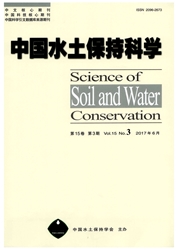

 中文摘要:
中文摘要:
金沙江上游地质灾害频发,地质环境演化相对复杂。为研究堰塞湖溃坝后堆积物的来源与坝体物质、沉积环境的关系,以金沙江上游雪隆囊古滑坡堰塞湖溃坝堆积物为主要研究对象,通过野外实地调查取样和室内粒度筛分试验,对雪隆囊滑坡堰塞湖溃坝堆积物的粒度进行测试,并分别对滑坡堰塞湖溃坝堆积物的上、中、下游3段的粒度特征进行研究。结果表明:从溃坝堆积体的上游到下游,粒度分布曲线分别为单峰、多峰、双峰;上游粒度组成主要以砾石为主,中游和下游主要以细砂和极细砂为主,粒度从上游到下游依次有明显的细化趋势,平均粒度由粗变细,分选性整体上较差和差。以上这些特点综合反映出溃坝堆积体的上游段到下游段的水动力条件在逐渐减弱,其中堆积体上游段砾石部分来自坝体物质,而中、下游段细粒部分既可能来自坝体,又可能来自堰塞湖溃坝前的上游湖相沉积层。
 英文摘要:
英文摘要:
[ Background] The upper reaches of Jinsha River is a geological disaster prone area, and the geological environment evolution is relatively complex. [ Methods] To study the relationship among the source of deposits after the break of dammed lake, the materials in the dam-body and sedimentary environment, taking the dam-break deposits from the dammed lake caused by Xuelongnang ancient landslide in the upper Jinsha River as the main research object, through field survey sampling and indoor sieving test of particle size, the particle sizes were tested, the granularity characteristics in the upstream, middle, and downstream section of the deposits were studied, and the composition of grain size and the size distribution curve of the deposits were analyzed in detail. [ Results ] The results showed that the distribution curves of grain sizes in the dam-break deposits for the upstream, middle and the downstream sections were unimodal, multimodal and doublet respectively. The composition of the grain size in the upstream section mainly was gravel, the hydrodynamic intensity was very strong, and it was affected by the single stable hydrodynamic condition. In the middle section, the main ones were fine sand and extremely fine sand, hydrodynamic intensity weakened mainly in the lower reaches. Compared with middle section, also main sizes in downstream were also fine and extremely fine, and the proportion of them increased; moreover, hydrodynamic intensity was even weaker in general. Regarding the relationship between deposits and materials of dam-body, the gravels were from the material of dam-body, and the fine particles might be partly from the dam-body, and partly from the lacustrine sediment in the upper reaches before the break of dammed lake. The particle size presented the trend of obvious becoming thinner from the upstream to the downstream, and the average particle size changed from coarse to fine. The sorting feature of dam-break deposits was poorer and poor. These characteristics reflected the gradual weakening o
 同期刊论文项目
同期刊论文项目
 同项目期刊论文
同项目期刊论文
 期刊信息
期刊信息
